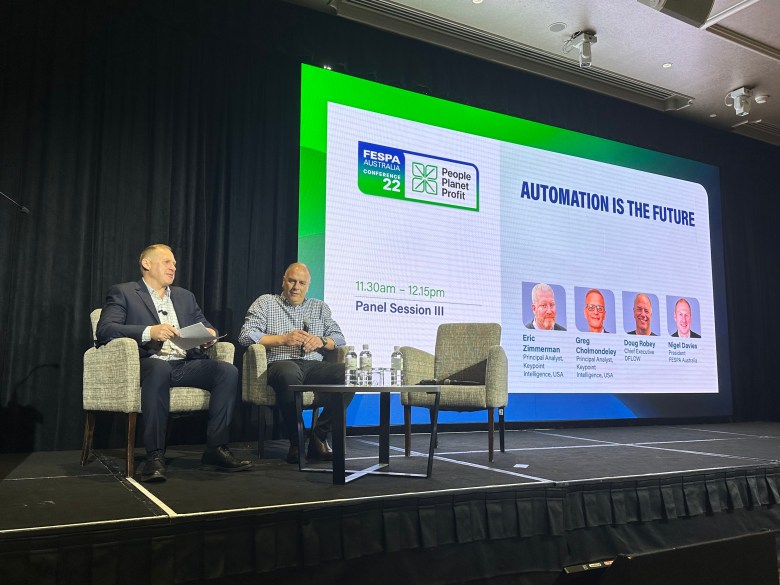
With a lack of skilled pre-press people and clients wanting faster turnaround times paired
with greater personalisation, companies need to leverage new technologies to achieve end-to-end automation and efficiency, according to a panel of speakers at the recent FESPA conference in Sydney.
The panel consisted of Keypoint Intelligence USA principal analysts Eric Zimmerman and Greg Cholmondeley who joined in remotely and DFLOW chief executive Doug Robey and FESPA Australia president Nigel Davies.
Automate – don’t fill unfillable jobs was the message by KeyPoint Intelligence based on their research.
“Given the challenges in the market, we are seeing more people invest in software for a couple of reasons. People have gotten over their concerns around security and Software-as-a-Service (SaaS)has become more affordable,” Cholmondeley said.
“They’re realising the benefits of software, as it’s now not as expensive with upfront costs and professional services to set up. The pandemic has also accelerated its uptake.
“And the biggest reason is that SaaS is a subscription model; it’s an operating expense. People don’t have to worry about this capital investment budget, and it fills in where they have an unfillable position.”
Zimmerman said a younger generation entering the workforce will also expect more businesses to adopt technology into their practices.
“Many millennials are now in the workforce and they expect the use of apps and other technology. SaaS is constantly upgraded and it never goes out of date. So, its usage is only going to continue as Gen Z enters the workforce,” he mentioned.
“So, businesses should automate where it makes sense to automate, and keep your human value where it makes sense. The goal should be to reduce your labour costs, reduce your losses and waste.”
Robey expanded on the automation theme, arguing that the key to automation lies in collecting rich data in a cloud-based MIS and working towards standardisation and integration in small steps.
“What is happening is that businesses are automating preflight. But that’s where it stops. What we must automate is the whole workflow. It takes a lot of sheer will and it’s not easy. But it can be done. You must have it in your business, if you want to build it for the future,” he said.
“Automation needs a trigger, and data is the key. And cloud-based MIS is what you need to have rich data.
“Then when you approach automation, you need people with different skills – you need software skills, you need development skills. Whether you outsource them or bring them in house, you need them alongside your production.”
Davies mentioned that the Australian print industry needs to push its standardisation across its product layer, and then move it further up the chain towards clients.
“This means they will have a print system where software is forcing clients either through a business-to-business portal, or through a basic web-to-print portal, with overlaying information in the format that they want,” he said.
“We already know how to deal with data once we get it down to the automation level. So, that’s where we need to go – we need to start standardising from the inside out with the view that you want to have clients interacting with us through it to print. And that way we can control that data so, the opportunity for automation is much stronger.”
Comment below to have your say on this story.
If you have a news story or tip-off, get in touch at editorial@sprinter.com.au.
Sign up to the Sprinter newsletter
